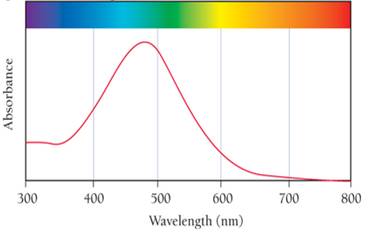
Concept explainers
Many aqueous solutions of complex ions display brilliant colors that depend on the identities of the metal ion and ligand(s). Some ligands bind selectively to certain metal ions and produce a complex ion with characteristic colors. These distinctive complex ions serve as qualitative indicators of the presence of particular metal ions. For example, Fe3+is identified by the rapid formation of the intensely colored pentaaquathiocyanatoiron(III) complex ion. [Fe(H2O)5SCN]2+, when thiocyanate, SCN-,is added to a solution containing hexaaquairon(III), [Fe(H2O)6]3+, according to the balanced chemical equation shown here:

Examine the absorption spectrum of an aqueous solution of [Fe(H2O)5SCN]2+ shown here and answer the questions.

Absorption spectrum of [Fe(H2O)5SCN]2+
- Based on the spectrum, what is the color of an [Fe(H2O)5SCN]2+ solution?
[Fe(H2O)6]3+, Produces a pale violet aqueous solution. Is the crystal field splitting energy, Δ, of [Fe(H2O)6]3+ smaller or larger than the Δ of [Fe(H2O)5SCN]2+?
[Fe(CN)6]3-, is red in aqueous solution. What can you conclude about the relative crystal field splitting energies of [Fe(CN)6]3- and [Fe(H2O)5SCN]2+?
Want to see the full answer?
Check out a sample textbook solution
Chapter 22 Solutions
Study Guide for Chemistry: Structure and Properties
- Please provide steps to work for complete understanding.arrow_forwardIdentify the Functional Groups (FG) in the following molecules. Classify C atoms as tertiary, 30, or quaternary 40. Identify secondary 20 and tertiary, 30 hydrogen atoms. Please provide steps to undertand each labeling.arrow_forwardIdentify the Functional Groups (FG) in the following molecules. Classify C atoms as tertiary, 30, or quaternary 40. Identify secondary 20 and tertiary, 30 hydrogen atoms. Please provide steps to undertand each labeling.arrow_forward
- Identify the Functional Groups (FG) in the following molecules. Classify C atoms as tertiary, 30, or quaternary 40. Identify secondary 20 and tertiary, 30 hydrogen atoms. Please provide steps to undertand each labeling.arrow_forwardIdentify the Functional Groups (FG) in the following molecules. Classify C atoms as tertiary, 30, or quaternary 40. Identify secondary 20 and tertiary, 30 hydrogen atoms. Please provide steps to undertand each labeling.arrow_forwardA certain chemical reaction releases 24.7 kJ/g of heat for each gram of reactant consumed. How can you calculate what mass of reactant will produce 1460. J of heat? Set the math up. But don't do any of it. Just leave your answer as a math expression. Also, be sure your answer includes all the correct unit symbols. mass M 0.0 x μ 00 1 Garrow_forward
 Chemistry: The Molecular ScienceChemistryISBN:9781285199047Author:John W. Moore, Conrad L. StanitskiPublisher:Cengage Learning
Chemistry: The Molecular ScienceChemistryISBN:9781285199047Author:John W. Moore, Conrad L. StanitskiPublisher:Cengage Learning Chemistry: Principles and ReactionsChemistryISBN:9781305079373Author:William L. Masterton, Cecile N. HurleyPublisher:Cengage Learning
Chemistry: Principles and ReactionsChemistryISBN:9781305079373Author:William L. Masterton, Cecile N. HurleyPublisher:Cengage Learning Chemistry & Chemical ReactivityChemistryISBN:9781337399074Author:John C. Kotz, Paul M. Treichel, John Townsend, David TreichelPublisher:Cengage Learning
Chemistry & Chemical ReactivityChemistryISBN:9781337399074Author:John C. Kotz, Paul M. Treichel, John Townsend, David TreichelPublisher:Cengage Learning ChemistryChemistryISBN:9781305957404Author:Steven S. Zumdahl, Susan A. Zumdahl, Donald J. DeCostePublisher:Cengage Learning
ChemistryChemistryISBN:9781305957404Author:Steven S. Zumdahl, Susan A. Zumdahl, Donald J. DeCostePublisher:Cengage Learning Chemistry: An Atoms First ApproachChemistryISBN:9781305079243Author:Steven S. Zumdahl, Susan A. ZumdahlPublisher:Cengage Learning
Chemistry: An Atoms First ApproachChemistryISBN:9781305079243Author:Steven S. Zumdahl, Susan A. ZumdahlPublisher:Cengage Learning





